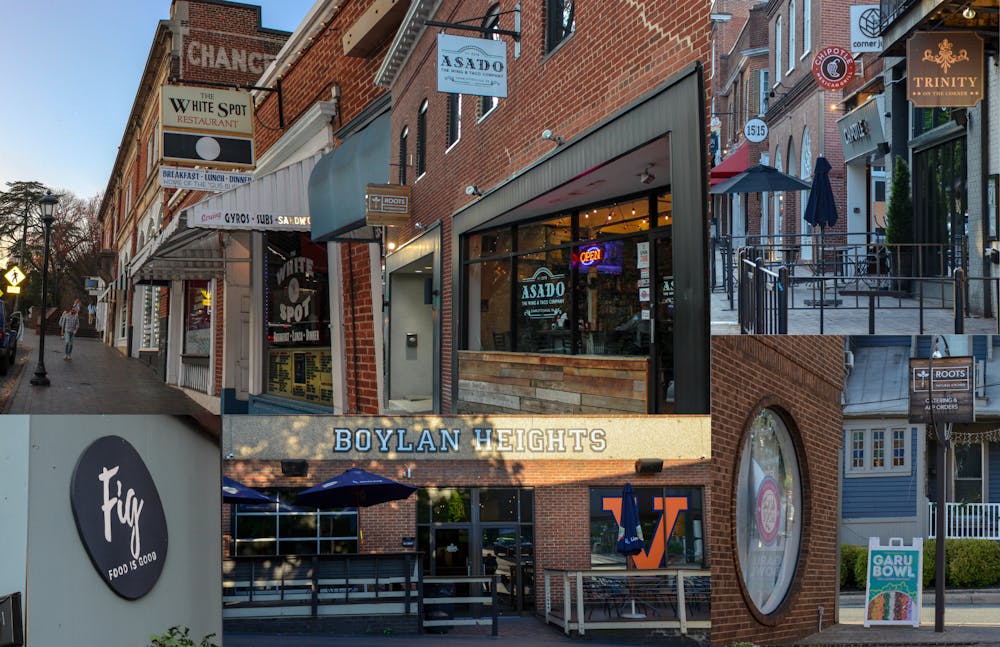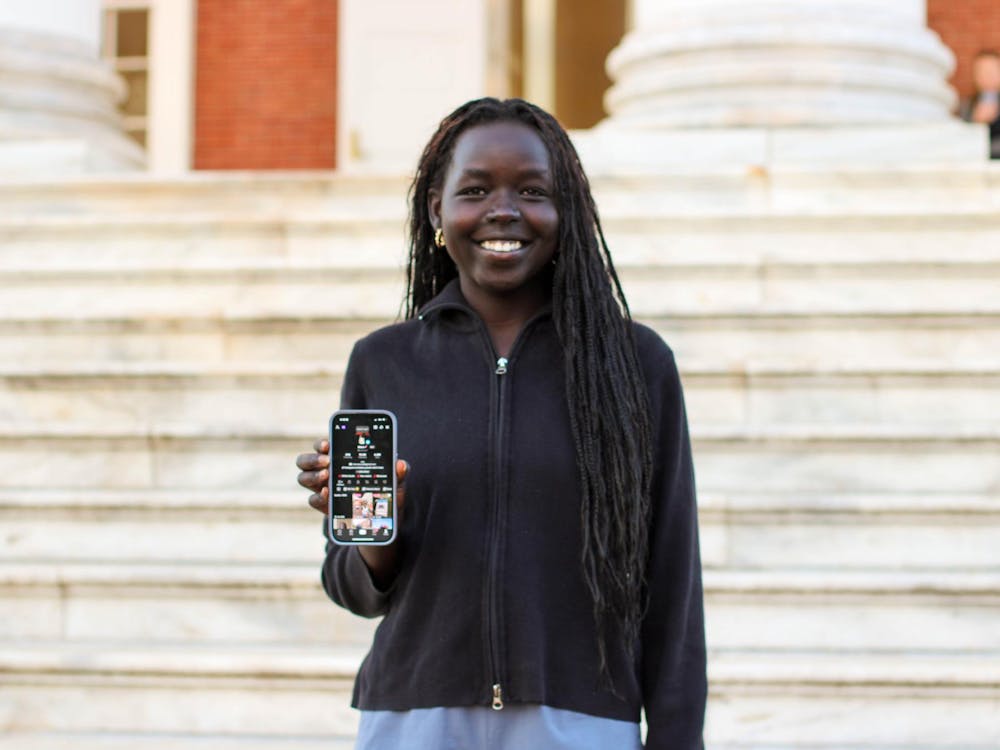Every day of the academic year, dining halls on Grounds and nearby restaurants are filled with the familiar sounds of plates clanging, forks scraping and vibrant student conversation. During their time at the University, students must navigate an intricate food system on and off Grounds.
Generally speaking, the dining spaces on Grounds serve a singular purpose — sustaining students, not necessarily satisfying their taste buds. However, beneath the surface of the culinary experience, dining both on and off Grounds contributes to students’ sense of community at the University.
The first-year student experience is undeniably defined by the dining halls. All incoming first-year students are required to participate in an “All Access” meal plan, granting them unlimited swipes into dining halls and the ability to exchange up to two meal swipes per day at retail locations such as Rising Roll in New Cabell Hall or West Range Cafe near the Amphitheater. As a part of their unlimited plan, these students also have at least $150 flex dollars, which they can use for à la carte meals across Grounds.
Among students, there is a tacitly agreed-upon hierarchy of dining halls, with Runk Dining Hall being praised for its variety and higher quality. By her standards, Second-year Education student Ella Sease confirmed these rankings.
“Towards the beginning of the year, Runk was definitely exceptionally better than the other two,” Sease said. “They had more options. The food was just better quality in general.”
By and large, it is no secret that the on-Grounds dining options are less than ideal. Sease acknowledged a variety of issues, including small serving sizes, rubbery, overcooked food and little menu variety from week to week. Sease said she has mixed feelings about the dining halls after her recent year on the unlimited meal swipes plan.
“I think on Grounds, it's better than what people say it is,” Sease said. “It gets a lot of hate, but I don't think it's awful.”
Adding fuel to the fire, third-year College student Jules Guthrie recalled her first-year dining hall experience as not overly accommodating to her dietary restrictions, particularly her choice to be a vegan. She ate from the vegan station each time, which got old fast, she said.
“There wasn't a lot of variation among the food that I was able to choose from,” Guthrie said. “It got a little repetitive and frustrating the year that I did have the meal plan.”
Above all, Sease said she particularly struggled with the dining halls’ hours of operation, with Observatory Hill Dining Hall, also known as O’Hill, shutting down at 9 p.m. each night and Newcomb being closed altogether Saturdays.
Regardless of the middle of the line quality, Sease has an understanding for the overarching practical constraints of the dining halls.
“From an overall perspective, I understand why it is the way it is, because it's hard to satisfy thousands of people at the same time,” Sease said. “So I understand why it has to be maybe not just the best cuisine ever.”
Looking beyond the lack of Michelin stars, Sease and Guthrie said the University dining halls do act as an incubator for first-year friendships, early morning debriefs and evening meet-ups, which makes the unlimited plan an overall net positive for first-year students.
Through this lens, the dining experience on Grounds encapsulates what being a University student is all about — connection. Both Guthrie and McGinnis look back on the social aspect of dining halls as being incredibly beneficial while adjusting to college life.
“It is tough to learn to cook for yourself and shop for yourself, and I think the dining halls really help with that transition,” Guthrie said. “They help you have a consistent meal every night, and I think that's a really positive thing for first-years.”
However, priorities change after a student’s first year at the University, especially once they have a solid network of friends. Given the dining hall hiccups — and the fact that students are not required to buy a meal plan beyond their first year — many upperclassmen opt for something different.
For Guthrie, navigating the dining halls with a vegan diet was just too difficult, and she subsequently refrained from purchasing a meal plan altogether.
“[I made] the decision to not have a meal plan in my second or third years, just so I could have a lot more control over what I was eating,” Guthrie said.
Third-year College student Max McGinnis went for another common upperclassmen option — the Elevate meal plan. Elevate offers students a way to supplement traditional meal swipes or weekly store-bought groceries with “credits” that apply to over 60 local restaurants, many of which are located on the Corner.
Some students choose Elevate to get rid of the bad tastes left in their mouths from first-year dining. Others simply use it to take full advantage of Charlottesville’s popular restaurants, from Roots to Corner Juice. But for many, signing up for Elevate is a practical decision.
McGinnis noted that many upperclassmen live far away from on-Grounds dining, and they seek efficient meal options amidst their busy student lives. These factors played a role for him, McGinnis said.
“I eat frequently outside of the dining halls, especially when walking outside to class [or] back to my apartment — [walking to] a dining hall is a pretty inconvenient route,” McGinnis said. “I thought having an Elevate meal plan … was a lot more efficient.”
For students who opt to forgo the on-Grounds dining scene, Charlottesville is a bit of a foodie heaven. From fine sushi dining at Ten to reimagined Southern classics at Maya over in downtown Charlottesville, there is a bite for everyone.
For McGinnis, The Local is the Charlottesville culinary superstar. With its regionally inspired takes on traditional American favorites, The Local has become a community favorite for many with their charming deck space and flavorful dishes.
“It is a very kind of small, kind of quaint restaurant, and I just really like the kind of the vibe it has going on in there,” McGinnis said.
As for the Corner, Guthrie and McGinnis agree upon its “iconic vibe,” fueling students with a quick caffeine pick me up from Grit or their one-of-a-kind order from Bodo’s Bagels.
“I haven't necessarily had my best meals in Charlottesville on the Corner, but I've had my most consistent meals in Charlottesville on the Corner, and it's always a good place to stop for a quick dinner or snack in between classes,” Guthrie said. “I wouldn't trade it.”
The University's cuisine culture is a complex reflection of both convenience and community. Students are constantly reshaping their eating habits, adjusting to the constraints of their meal plans and exploring what the Charlottesville food scene has to offer. Guthrie, reflecting on her own fluid food experience, said that figuring out what food works for her has been an important part of her time as a college student.
I think it was a good learning curve, and overall it's really shaped me into being a better adult, which is part of the thing that U.Va. is all about,” Guthrie said.







